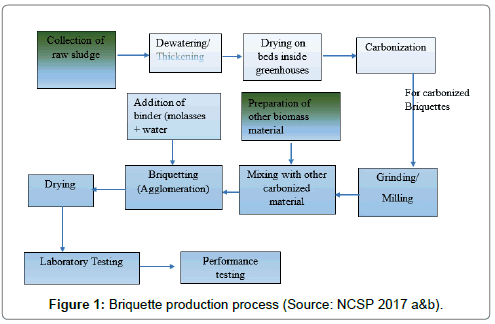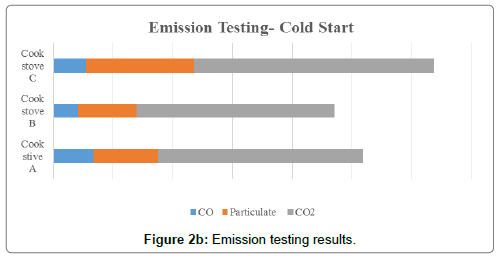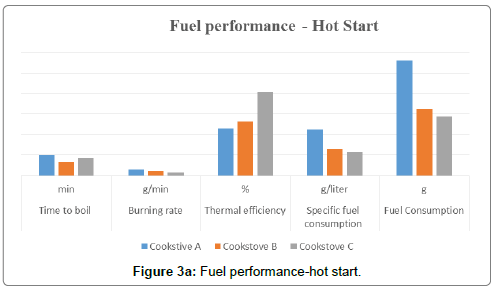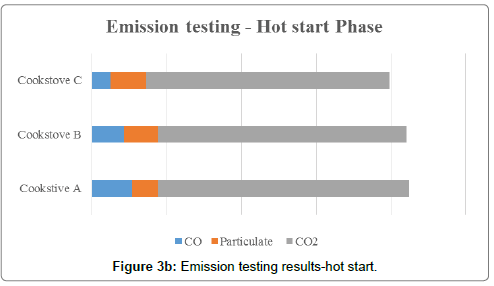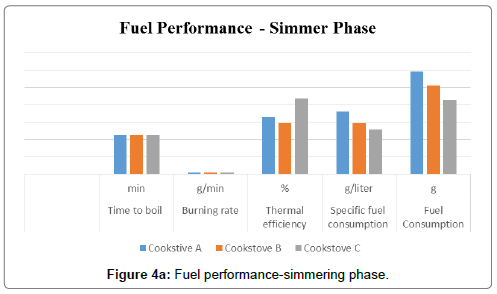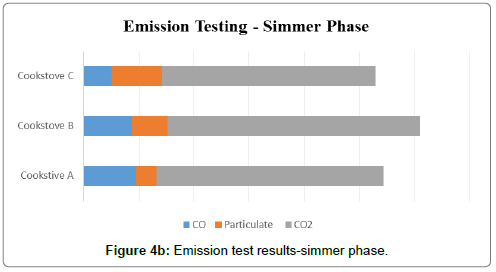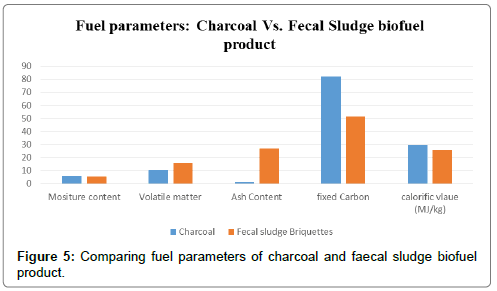Performance of Composite Fecal Sludge-Biofuel in Improved Cook Stoves
Received: 31-Jul-2018 / Accepted Date: 28-Sep-2018 / Published Date: 05-Oct-2018 DOI: 10.4172/2573-458X.1000161
Keywords: Briquettes; Performance; Cook stoves; Adaptability; Water boiling test
Introduction
There has been a quest to develop efficient, environmental friendly, safe and sustainable energy technology methods (cook stoves) together with alternative biomass fuels using locally available materials. The Nakuru Water and Sanitation Services Company (NAWASSCO) and partners implement the Nakuru County Sanitation Programme (NCSP) [1] and developed the innovative FssDbb using sludge obtained from septic tanks, pit latrines and combined with sawdust from within the township. Technologies testing have been one of the crucial activities for the performance indicators of the alternative biomass fuels and cook stoves. The study is a follow-up on the briquette product (FssDbb) development (design) process and aims at testing the performance with different types of cook stoves for house hold use. The fuel briquettes are designed and intended for both household and institutional use. After briquette development [2,3], the water boiling test was carried out using Kenya Ceramic Jiko (KCJ), Jiko Koa and Envirofit super at the University of Nairobi laboratories using the WBT as outlined in the International Workshop Agreement (IWA) framework for cook stove testing. The test is in response to a number of developed cook stoves and improved biomass fuels that call for testing their efficiency and efficacy.
A high percentage of households in developing countries use biomass fuel such as charcoal and firewood as their main source of household energy. Past studies [4] have linked traditional methods of consumption of biomass fuel, for example cooking with firewood and charcoal; with low efficiency, negative environmental consequences, including high rate of desertification due to cutting of trees, and increase in carbon emissions. NCSP conducted a market study in the Nakuru town area both by qualitative (focus groups discussions) and quantitative (Akvo Flow survey tool) methods. This was to determine the market size and the suitability of the fecal sludge related biofuel products for the Kenyan market.
Methodology
Briquette production
The briquettes were made using fecal matter, sawdust, and charcoal dust (FssDbb) at a ratio of 1:1:2 and 5% molasses as a binding agent. The blend was chosen after a previous NCSP research where several tests were performed on raw materials and with different binding agents. The bio-fuel products were made using carbonized raw materials (sludge, sawdust and charcoal dust), produced by using improved drum kilns, agglomeration with a rotating drum and the output spherical fireballs were open air dried [2,3]. The briquette making process is as shown in Figure 1.
Selection of cook stoves
The FssDbb performance was tested by applying the standardized WBT using three commonly used varieties of cook stoves in Kenya to provide a basis for comparison of the new fuel relative to the existing fuels. The tests were guided by the international organization for standardization (ISO) framework for testing cookstoves based on four specific parameters; efficiency, indoor emissions, total emissions and safety. The frame work provides for categorization of cook stoves into five tiers (0-4), where tier 0 is the lowest and tier 4 with the highest performance [5]. The commonly used cook stoves for the target test market (households within Nakuru County), were selected with the following details:
KCJ: Is a commonly used Jiko within Nakuru County. In a previous study [6] it was identified to have a good rating in thermal efficiency with low fuel consumption especially in the low power phase (long duration cooking) when different types of cook stoves were compared. It is thus the most preferred cook stove in a majority of low income households in urban and peri-urban areas in Kenya.
Jiko koa: The cook stove is an industry produced standard model with no variation and is an improved cookstove which is second in penetration in the Kenyan market.
Envirofit super: Is a cook stove on the list of emerging improved technologies.
Water boiling test
The WBT tests were undertaken at the University of Nairobi laboratory and repeated three times as in the standardized protocol. The tests were done for efficiency and emission of cook stoves in a controlled laboratory setting that consisted of three phases; Phase 1 (High power- Cold start), Phase 2 (high power-Hot start) and Phase 3 (Low power- Simmering). The FssDbb were used as fuel for the three categories of cook stoves. The parameters determined included emission of carbon dioxide (CO2), carbon monoxide (CO), time to boil, burning rate, thermal efficiency, specific fuel consumption, fuel consumption and amount of particulate matter as in the following subsections.
Performance and efficiency testing
The performance testing encompassed time to boil, specific fuel consumption (sfc), thermal efficiency and burning rate as is described in the (WBT) with brief definitions as below:
Time to boil: is the time (t) in minutes taken to bring water to boil.
Specific fuel consumption: Is the amount of solid fuel equivalent used in achieving a defined task divided by the weight of the task, that is, the amount of fuel needed to boil 1 kg or 1 liter of water when starting from a cold cook stove and also is applicable in the other phases, expressed as:

Fuel consumption: Is the amount of fuel in grams that is consumed in bringing the water to boil and is calculated by subtracting weight of dry fuel after water boils from the dry weight of fuel before ignition.
Thermal efficiency: Is the extent to which a cook stove transfer’s heat to the pot when cooking or the portion of heat utilized in directly heating the cooking pot until water reaches boiling point. The remaining portion of heat is lost to the surrounding environment and is represented by the following formula:

Where: Energy required to boil water (EH2O,Heat) equals to mass of water (MH2O) multiplied by specific heat capacity (Cp) and by change in temperature (Δt) given in equation

Cp, is estimated at 4.186 KJ/KgK
Where; Wvc is mass of water evaporated and 
Energy released is equal to mass of fuel (M) used multiplied by heating value (HV)

Burning rate: Is the weight of fuel consumed (Fcd) divided by the time (Δtc) taken to boil the water or the consumption of fuel when water is brought to the boiling point.

Specific fuel consumption (SCcold): Is the amount of fuel that is needed to produce 1 unit of output. In this case output is boiled water. In the high power cold starting the specific fuel consumption is the amount of fuel that is needed to boil 1 kg or 1 liter of water when starting from a cold cookstove. The same formula is used in the high power hot star calculated as:

Fuel consumption: Is the amount of fuel in grams that is consumed in bringing the water to boil. It is calculated by subtracting weight of dry fuel after water boils from the dry weight of fuel before ignition.

Emission testing
Involved measurement of concentration and composition of Carbon Monoxide (CO), Carbon Dioxide (CO2) as well as Particulate Matter or generally the emissions form the exhaust fumes. Emission testing is part of WBT protocol version 4.2.3.
Exhaust carbon concentration (CO2 and CO): Includes the carbon atoms in Carbon Dioxide (CO2), Carbon Monoxide (CO) and carbon content in particulate matter (PM). The measure determines the carbon atoms in the cook stove exhaust fumes as;

A molecule of Carbon Dioxide or Carbon Monoxide contains 1 atom and are determined respectively by the following formulae

Particulate matter: In exhaust fumes is calculated by equation 10 and is assumed to contain 80 percent carbon, based on WBT.

Findings and Discussions
The results of an average of WBT laboratory tests for the three phases are outlined in sections 3.1 to 3.3 consisting of tables and figures for results illustrations.
Phase 1-cold start
The findings for phase 1 tests are as shown in Table 1. Based on Table 1 and Figure 2a; Cook stove A, was only best in burning rate and equivalent to C. Cook stove B; was best in time to boil, CO, CO2, and particulate matter. Cook stove C, was best on thermal efficiency, specific fuel consumption and fuel consumption. Overall as in Figure 2b; the performance of Cook stove B was the best based on its low emission except for time to boil, burning rate, specific fuel consumption, thermal efficiency and fuel consumption. Cook stove A was second best in performance for two of the emission parameters while C was best on CO as a parameter though almost comparable to A and highest volume of carbon dioxide and particulate matter. Cook stove B would then be selected based on emissions as A and C were better in thermal efficiency in the range of 20%-50%.
| Parameters | Units | Cook Stoves | ||
|---|---|---|---|---|
| A | B | C | ||
| Time to boil | Min | 31 | 15 | 20 |
| Burning rate | g/min | 8 | 14 | 8 |
| Thermal efficiency | % | 19 | 16 | 24 |
| Specific fuel consumption | g/liter | 110 | 86 | 71 |
| Fuel consumption | g | 270 | 217 | 180 |
| CO | Ppm | 67 | 41 | 55 |
| Particulate | µg/m3 | 108 | 98 | 180 |
| CO2 | Ppm | 344 | 331 | 402 |
Table 1: Briquettes performance in Phase 1-Cold start.
Phase 2-hot start
The findings for phase 2 tests are as shown in Figure 3a and Table 2 that shows the performance of the cook stoves in the high power, hot-start phase. Cook stove A was outperformed by the other cook stoves in regard to time taken to boil, thermal efficiency and high fuel consumption. Cook stove B was rated second in all the parameters but comparable to C on emission parameters. Overall, Cook stove C outperformed the other cook stoves in all aspects during the high power hot start phase. The good performance was notable in low burning rate, high thermal efficiency, and low fuel consumption. Statistically B and C would be in the same range.
| Parameters | Units | Cook stove A | Cook stove B | Cook stove C |
|---|---|---|---|---|
| Time to boil | Min | 20 | 13 | 17 |
| Burning rate | g/min | 6 | 5 | 3 |
| Thermal efficiency | % | 46 | 53 | 81 |
| Specific fuel consumption | g/liter | 45 | 26 | 23 |
| Fuel consumption | g | 112 | 65 | 58 |
| CO | Ppm | 54 | 42 | 25 |
| Particulate | µg/m3 | 34 | 46 | 47 |
| CO2 | Ppm | 336 | 333 | 326 |
Table 2: Briquettes performances in phase 2-Hot start.
Figure 3b shows the results of emission tests for the three cook stoves. Cook stove A produced the highest amount of carbon monoxide and carbon dioxide followed by Cook stove B. This is unlike Cook stove C whose performance was best in CO and CO2 emissions and highest in Particulate Matter. It was comparatively better in the hot-start phase for both fuel performance and emissions.
Phase 3-simmering
The findings for phase 3 tests are as shown in the Table 3 and Figure 4a below that shows the results for fuel performance in the low-power simmer phase. The time to boil and burning rate were similar for the three cook stoves. However, the performance of B was second to C in most cases except in thermal efficiency and CO2. Notably, Cook stove C outperformed all except on Particulate Matter.
| Parameters | Units | Cookstove A | Cookstove B | Cookstove C |
|---|---|---|---|---|
| Time to boil | Min | 45 | 45 | 45 |
| Burning rate | g/min | 2 | 2 | 2 |
| Thermal efficiency | % | 66 | 59 | 87 |
| Specific fuel consumption | g/liter | 72 | 59 | 51 |
| Fuel Consumption | g | 118 | 102 | 86 |
| CO | Ppm | 47 | 44 | 25 |
| Particulate | µg/m3 | 19 | 32 | 46 |
| CO2 | Ppm | 206 | 229 | 194 |
Table 3: Briquettes Performances in Phase 3-Simmering.
Figure 4b is the results of emission testing in the simmer phase. Cook stove A produced the highest amount of carbon monoxide and the reverse was true for Particulate Matter emission. Overall, Cook stove C outperformed the other two in this phase and Cook stove B and A shared equal second position in different parameters. Cook stove B had the highest emission in CO2. Though Cook stove C was better in all parameter performance, Cook stove A and B showed mixed results.
Table 4 and Figure 5 are given to illustrate and compare the physical performance of lump charcoal (original charcoal that is made by burning logs of wood) and the FssDbb that was tested in the above results and discussions. The charcoal results are from a prior University of Nairobi laboratory test. The variation in the results may be attributed to preparation before testing, the machine for briquetting and the equipment for the testing. It can be noted that specific fuel consumption, CO2 and CO are within the recommended standards as in Table 4 of the identified reference standards. Time to boil and Particulate Matter are above the range specified. The density and ash content were not within limits but the rest of the physical quantities (moisture content, volatile matter, fixed carbon, and caloric value) met the standards in Table 4 for the faecal sludge.
| Briquette Characteristics | Charcoal Source : University of Nairobi Lab | Fecal sludge Briquettes | Standard Values |
|---|---|---|---|
| Moisture Content | 6.2 | 5.49 | <12% |
| Density | - | - | 1000-1400 kg/m3 |
| Ash Content | 1 | 26.7 | 0.70% |
| Volatile Matter | 10.6 | 15.9 | 35% |
| Fixed Carbon | 82.1 | 51.3 | 58.13% |
| Calorific Value | 29.8 | 25.93 | 17.5 MJ/kg |
| Specific Fuel Consumption | - | as above | 228 g/l |
| Burning Time | - | as above | 14.94 min |
| Carbon dioxide | - | as above | 5000 ppm |
| Carbon monoxide | - | as above | 50-200 ppm |
| Particulate Matter | - | as above | 25 mg/m3 |
Table 4: Reference standards.
Marketing of Faecal Biomass Fuel
Charcoal is confirmed the main type of fuel used by a majority of households in Kenya and is followed by kerosene and natural gas [7-11]. A market study [1,6] was conducted to establish customer views and attitudes on faecal briquettes and fuel pellets (362 households and 238 businesses/institutions). Perception towards the product was expected to be adverse but households were found to respond positively towards faecal matter briquettes. This was influenced by household assurance on safety of the product through understanding of the production process. Consumer education is thus recommended before introducing the products.
In addition, research should be carried out on stoves to optimise performance of briquettes and marketing [1,6]. It was further noted that there is a tendency for switching of fuels in households with charcoal as the immediate alternative fuel in peri urban areas. Natural gas is ranked top followed by firewood, kerosene and charcoal. The study showed that eighty% of the population were positive about using briquettes made from different biomass wastes including human waste and were more appealing among low-income households. The level of satisfaction with a particular type of fuel is based mostly on factors such as performance, cost and cleanliness (user friendliness). Smoke emission becomes a major cause of dissatisfaction.
Likewise, majority of household’s choice of equipment is driven by cost, efficiency and level of smoke emission. The preferred technology for most households was Kenya Ceramic Jiko (KCJ) with Jiko Koa being perceived as efficient although more expensive. To fuel vendors, cost would be a crucial factor as market awareness of alternative fuel (mainly biomass briquettes) was also noted as good. On average, households spend approximately Ksh. 1,323 on purchase of equipment and use approximately Ksh. 1,110 on fuel per month. Consumers proposed packaging in small quantities of 2 kg or 5 kg packets [1,6 and pricing of briquettes to be less than half a dollar per 1 kg.
WBT showed that faecal matter briquettes burnt longer than charcoal and had less emissions and majority of the household’s cook in confined places that are without defined kitchen space thus prone to indoor pollution [12]. Briquettes were positively received more than pellets due its compatibility with their fuel equipment and cost efficiency. The households indicated preference to purchase the fuel but this was dependent on household’s income.
Conclusion
Briquettes made from a combination of carbonized feacal matter (25%) and sawdust (25%) and charcoal dust (50%) were found to feasible with both Jiko Koa and KCJ cookstoves and are the most common types in the market. The performance of cook stove type A when using fecal sludge biofuel product lagged behind B and C in all the Phases of the WBT tests. The performance of the fuel in the three cookstoves improved from high power phase to Low power phase. Cook stove C was best in all the phases considering the thermal efficiency, specific fuel consumption and fuel consumption. This makes the fuel suitable for cooking food that takes less time to cook as well as for those that takes relatively long time to prepare. Overall Cook stove B was performed better in phase 2. Low briquettes consumption indicated that the fecal matter briquettes are an efficient form of fuel. Burning rate and fuel consumption indicates that the fecal sludge - sawdust briquettes burn for a long period of time which makes the fuel suitable for cooking any type of food. Based on the parameters in the tables and the figures, Cook stove C (Envirofit) performed better followed by Cook stove B (Jiko koa - though preferred) and least was Cook stove A (KCJ) with FssDbb product. High thermal efficiency for the phases indicated that the heat generated was utilized well for the task that was intended. Emissions recorded were relatively low but requires that the stoves should be used in well-ventilated places.
Acknowledgements
This research is part of the research partnership between Nakuru County Sanitation Programme (NCSP), Nakuru Water and Sanitation Services Company Ltd. (NAWASSCO) and Egerton University. NCSP is a European Union co-funded programme implemented by NAWASSCO with the support of the Nakuru County government, Umande Trust, SNV Netherlands Development Organisation and Vitens Evides International. The research benefitted from the Aqua for all managed VIA Water fund and University of Nairobi laboratories. The authors gratefully acknowledge use of the services and facilities of the aforementioned institutions. We also appreciate Kelly Wanjala and Kevin Nyandeje for their technical support in the briquetting process.
References
- NCSP (2017) Consumer pilot study: Establishing performance and acceptance of fecal matter briquettes in Nakuru’s low income areas.
- Mbuba MJ, Nyaanga DM, Kabok PA, Eppinga R (2017) Effect of shapes, binders and densities of faecal matter-sawdust briquettes on ignition and burning times. J Pet Environ Biotech 9: 1-5.
- Mbuba MJ, Nyaanga DM, Kabok PA, Eppinga R (2017) Effect of mix ratios and binders on physical and combustion characteristics of faecal matter sawdust briquettes. Int J Emerg Technol Adv Eng 7: 1-6.
- Lewis JJ, Pattanayak SK (2012) Who adopts improved fuels and cook stoves? A systematic review. Environ Health Perspect 120: 637-645.
- Guidelines for reporting and analyzing laboratory tests results for biomass cooking stoves (2017) Department of Energy, Politecnico di Milano.
- Nunes LJR, Matias JCO, Catalao JPS (2014) Mixed biomass pellets for thermal energy production: A review of combustion models. Appl Energy 127: 135-140.
- Gachuri WG (2015) Optimising the utilisation of sawdust of eucalyptus tree species: A fuel for tea industry.
- GoK (2013) Analysis of the charcoal value chain in Kenya. Ministry of environment, water and natural resources.
- http://erepository.uonbi.ac.ke:8080/bitstream/handle/11295/56294/Njenga_Evaluating%20Fuel%20briquette%20technologies.pdf?sequence=3&isAllowed=y
Citation: Irungu J, Nyaanga D, Eppinga R, Aguko KP (2018) Performance of Composite Fecal Sludge-Biofuel in Improved Cook Stoves. Environ Pollut Climate Change 2: 161. DOI: 10.4172/2573-458X.1000161
Copyright: © 2018 Irungu J, et al. This is an open-access article distributed under the terms of the Creative Commons Attribution License, which permits unrestricted use, distribution, and reproduction in any medium, provided the original author and source are credited.
Select your language of interest to view the total content in your interested language
Share This Article
Recommended Journals
Open Access Journals
Article Tools
Article Usage
- Total views: 3869
- [From(publication date): 0-2018 - Nov 15, 2025]
- Breakdown by view type
- HTML page views: 2976
- PDF downloads: 893

